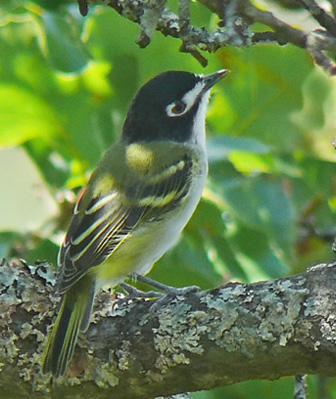By John Shackford

Draper Lake, where we recently had our fun club picnic, was for a number of years, the site of research on the Black-capped Vireo (Vireo atricapilla). This endangered species is small but strikingly beautiful, one of my personal favorites. And the species has an interesting history in Oklahoma: the Norman (Oklahoma) Audubon Society, I believe, submitted the original endangered species petition that led to its listing. The species once nested north from old Mexico to south-central Kansas. It was gradually lost in Kansas and most of northern Oklahoma; nest parasitism by the Brown-headed Cowbird was believed to be the primary problem. Prime habitat for the Blackcap is a mix of grasslands and variable height tree vegetation, some of which extends close to the ground, where the vireo usually nests about waist high. Blackcaps usually nest in colonies of 2 or more pairs.
About 15-16 years ago, Kathy Reeves, a member of our club who moved out of state many years ago but has kept up her club membership all these years (HI KATHY!), found a male Blackcap singing on the east side of Lake Draper here in central Oklahoma, and reported it—with exquisite directions—to John Newell. At that time, my wife Melissa and I were working under both an endangered species permit for the Blackcap and a cowbird collection permit. We visited Kathy’s area and almost immediately found 1 or 2 recently fledged vireos being fed by adults. Expanding the search area over the next several years, 5 locations on the east side of Lake Draper were found at 1 time or another, all with small to very small populations. Over these years, all under the necessary permits, researchers aided these small populations by finding nests and removing cowbird eggs and young. The most birds we ever found at 1 location were 7 males and 2 females; I always felt if we could get about 7-8 breeding pairs in 1 spot it might justify asking for wildlife money to trap cowbirds, but the population always remained below this modest population threshold. The birds at Draper were found primarily in an area that had burned a number of years earlier and subsequently grown up in scrubby oaks intermixed with grasslands. But the oaks there finally appeared to get too large and thick to be good habitat for the vireos.
Recently I saw on <OKBIRDS@lists.ou.edu> that someone had heard a Blackcap at Draper, but I have been unable to find out where. New areas at Draper have been burned over in the last several years and perhaps the bird was heard on 1 of these areas.
For a number of years (and perhaps even now) a small population existed in Blaine County northwest of Oklahoma City. This population was researched extensively for a number of years in an effort to save it. Cowbird control, cowbird egg and young removable from vireo nests, and habitat modification were all used to try to recover the species there, but populations seemed to remain about 15 nesting pairs or fewer for most years. Finally these efforts were abandoned as non-productive on a long-term basis.
But there is a success story in Oklahoma. In the Wichita Mountains and adjacent Ft. Sill reservations, a few Blackcaps were found a number of years ago. Extensive cowbird trapping and cowbird egg and young removal from vireo nests has resulted, as of 2005, in over 1250 Black-capped Vireos in the Wichita Mountains and over 500 more on Fort Sill, and I think the numbers are still going up. My hope is that birds from this southwest Oklahoma population will spill over into new areas, including central Oklahoma: we have had large fires in central Oklahoma in recent years that may create vireo habitat. The turnaround for the species in the Wichita Mountains/Fort Sill area has been remarkable, a true endangered species success story. So if you want to see or photograph Blackcaps, head to the Wichitas. If you are looking for a bigger challenge, head to the east side of Lake Draper.
